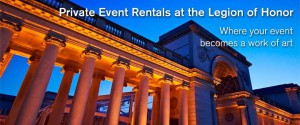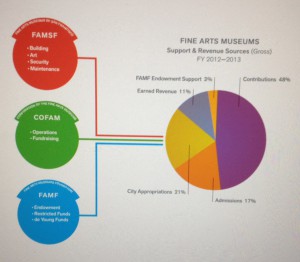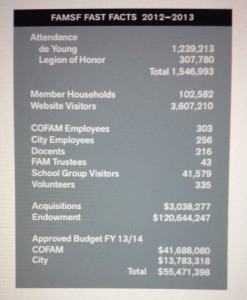Shannon E. Barry
AAD 610
MktgMediaComm II
3/1/2015
Final Marketing Plan: The Legion of Honor, San Francisco
Objective: The objective of my marketing plan for the Legion of Honor, a museum in San Francisco, is to get the San Francisco locals more involved at the Legion. Involved meaning visiting more, using the space for local events, and using the Legion as hub for local activities as well as a place for tourists to visit.
I: Introduction
The Palace of the Legion of Honor is a museum in San Francisco, California. The groundbreaking to build the museum was in 1921 and was the building was complete in 1924 (). It was funded by the sugar magnate Adolph B. Spreckles. His wife Alma persuaded him to create the Legion of Honor in San Francisco after she fell in love with the design of the French Pavilion that was located in San Francisco’s Panama Pacific International Exposition (). It was opened on Armistice Day in 1924. The building was always intended to be an art museum.
The museum continually hosts traveling exhibits. These are a draw for both locals and tourists. But, when the museum does not have an extra exhibit, it is mostly tourists and school groups that visit. As one half of the Fine Arts Museums of San Francisco (FAMSF), the Legion of Honor is closely associated with the De Young Museum. The De Young is by far more popular, getting more visitors and creating more revenue. But The Legion hold some amazing art and history. Though there are major differences in the two museums, they are both integral parts of the San Francisco landscape.
II: SWOC Analysis
To make the Legion more prominent in local life, my marketing plan has three strategies. One is using social media. While the Legion is active on Facebook, they need to use various types of social media and use it to their advantage. The second strategy is to use the museum for more public, and local events. The third is to use direct marketing to reach various resident audiences.
Case Study Analysis Part One
- Economic Scan
- The museum (and its sister museum, the de Young) is in San Francisco, a very expensive city
- The smaller numbers of people going to museums in the general trend is a concern
- It is under the umbrella management and supported by the FAMSF (Fine Arts Museums of San Francisco)
- Fine Arts Museums: Support and Revenue Sources (Gross)
- Contributions 48%
- Admissions 17%
- City Appropriations 21%
- Earned Revenue 11%
- FAMF Endowment Support 3%
- City Appropriations (21% of support and revenue sources)
- Fine Arts Museums of San Francisco (building, art, security, maintenance)
- Corporation of the Fine Arts Museums (operations, fundraising)
- Fine Arts Museum Foundation (endowment, restricted funds, de Young funds)
- The museum seems to be finically sound, as it gets many private contributions and can earn revenue through both ticket sales and venue rentals
- Money
- Acquisitions $3,038,277
- Endowment $120,644,247
- Approved Budget FY 13/14 –COFAM $41,688,080
- City $13,783,318
- Total $55,471,398
- Being paired organized with the De Young (under FAMSF) is a great advantage
- They are partnered in many events, and hold different parts of larger exhibits at the same time bringing people to BOTH museums
- Memberships are for both museums bringing new audiences to each of them
- Holding traveling exhibits brings more people from out of town (and the Bay Area in general) to the museum to see both the new and temporary exhibit but its permanent collections
- It is definitely a must see tourist destination and gets lots of business from such tourists and tour groups
- Demographic Scan
- Attendance (FAMSF):
- de Young 1,239,213
- Legion of Honor 307,780
- Total 1,546,993
- Other Statistics
- Member Households 102,582
- Website Visitors 3,607,210
- COFAM Employees 303
- City Employees 256
- Docents 216
- School Group Visitors 41,579
- Volunteers 335
- National trends have been that modern/contemporary art museums and exhibits have been the most popular, while more traditional museums have been seeing lower numbers in attendance and participation.
- In 2012 the Legion of Honor/De Young was named the Number Four largest museum in the Bay Area, with a revenue of $35,471,922, and attendance being 1,588,654 visitors.
- Attendance has dropped between 2012 and 2013, BUT not by a large number
- San Francisco City Demographics (2010, 2013)
- 2013 Population: 837,442
- High school graduates: 85.9%
- People who hold a bachelor’s degree or higher: 52%
- White: 48.5%
- Asian: 33.3%
- Latino: 15.1%
- African American: 6.1%
- Native American: 0.4%
- Two or more races: 4.7%
- San Francisco is a diverse city (in both race and age), with high education levels
- Higher education levels would seem to indicate more participation in the arts
- The FAMSF have an attendance number that is over the overall population of the county, so tourists and school tour groups obviously play a large part in numbers for attendance and participation.
- Cultural Scan
- San Francisco is a diverse and liberal city
- It has a history of appreciating art
- SF MOMA is the most popular museum in the city
- Multitudinous types of art are present in the city
- The Legion of Honor museum offers tour and programs for all ages (including education programs for young children all the way up to college groups)
- Many people in the Bay area go to museums and local art exhibitions on the weekends and in free time
- The Legion needs to incorporate more technology to keep up with its competitors
- Other Environmental Elements
- Tourism is insanely important to FAMSF and the Legion of Honor
- The number of attendees for the two museums associated with the FAMSF is larger than the population of the entire county!
- San Francisco itself is a factor
- It is an art city
- Known for its appreciation of art in ALL of its forms
- Many tourists are drawn for different reasons
- There is a huge culture of supporting the arts and museums
Case Study Analysis Part 2 — SWOC Analysis
| Strengths | Weaknesses | Opportunities | Challenges | |
| Cultural Product(s) | -lots of significant pieces (both historical and artistic)
-Large and varied collection -Many time periods represented -traveling exhibits! International reputations |
-some people see museums as boring
-viewed as “stuffy” and “old school” -very formal, can be seen as intimidating subject material
|
-Beautiful art and history artifacts
-amazingly large collection, can change exhibits to foster new interest -hosts traveling exhibits and gets people to the museum from out of town -outside spaces used for large and “current” exhibits |
-Need to be open to displaying more “modern” types and genres of art
-need to get more people of ALL ages into the museum -need to foster a younger audience
|
| Pricing | -Member tickets are free
-Most tickets are $10 or under (Adults: $10, Senior: $7, Student: $6, Youth: $6) -reasonable pricing -Group prices available |
-Unlike some museums in Washington DC and London, the museum is not free to enter
-tickets for certain events cost more |
-often get student or group tours into the museums for special exhibits, even if prices are higher | -Getting lower income people into the museum
-Need to pay to park, or take public transportation and then a ticket on top of that
|
| Place (Access) | -in San Francisco, a place know for love of culture and arts
-easy to access, in the city itself -Great views |
-San Francisco can be expensive to travel too
-parking in the city is difficult -The park it is located in can be a bit confusing to navigate |
-Again, great views, good for photography and for venue rentals | -Getting people into the museum (as it is not on a main street downtown)
-the parking is hard |
| Promotional Efforts | -Part of FAMSF, multiple outlets to promote
-advertise together with the De Young |
-Not a brand in itself
-Always associated with the De Young |
-Good to advertise with FAMSF most of the time, gets the name out well | -Needs to find a way to advertise as a single entity to bring more attention |
III: Scheme
Scheme 1: Social Media
Social media marketing is a relatively new marketing method. Using various websites such as twitter, Facebook, Instagram, Tumblr, and Snapchat, companies and institutions can reach out to large audiences. People of all ages use social media, though it is dominated by a younger demographic. Though the Legion of Honor has a Facebook, an Instagram, a twitter, and a few other accounts, I do not feel that they use them to the best effect.
The Legion of Honor’s Facebook page is very active and has many followers. They post every day about the current exhibits in the museum. The posts include information about setting up exhibits and certain pieces are featured, along with pictures. But I think they should have more fun with their social media resources. Posting about other local events would foster relationships with businesses in San Francisco. Using the museum’s Instagram to post pictures of the museum and its guests would showcase the beauty of the building and surrounding area. Taking a cue from the Los Angeles County Museum of Art (LACMA), the Legion of Honor should create a Snap Chat account. To use this type of social media effectively, they need to send snap chats that are funny and witty. To keep them surprising and fun, they should only be sent once a week.
To use these social media tools effectively, they need to have a schedule for posting information (general and about specific events), facts about their institution, news on other similar institutions, news for partner institutions, etc. This way, they could get their online audiences’ attention, but by using a strict schedule they would not overwhelm those who follow them on their various accounts.
Scheme 2: Event Venue/Movie Night at the Museum
To get more locals into the museum, I would suggest using it as a venue for regional events, city wide celebrations, and more private events. Though the Legion is already used for private events, as it is a gorgeous space for weddings and parties, having the space fulfill this role even more would bring locals into the buildings and grounds more often.
Though private venue rentals generate revenue for the museum, the space could also be used as a venue for city or state events, bringing in more people who might never think of going to the museum. For citywide events, holidays, and other local celebrations that utilize multiple locations, the museum could be used for more formal events (inside the museum), and other events can be placed outside on the grounds of the museum.


Among the strengths of this tactic are that the Legion of Honor is already used as a venue, it is a gorgeous place to host an event, as they have held private events before the staff already knows how to set up events. The main strength of this plan is that the museum currently works closely with the city. But, there are a few weaknesses to this strategy. These include logistical issues for holding large parties or occasions. It is in one of the very large parks in San Francisco, this makes parking and general transportation difficult. This may bring about issues that make it hard for people to get there, and if a place is not easy to get to, less people will come.
If these events were held at the right time of year (either summer, or the off season for tourists) then they would draw in mostly locals. If held in the summer the movies could be shown outside on the lawn in front of the museum. If held inside one of the larger rooms used for events could be used. This would be a fun way to gather people at the Legion of Honor. It is an informal way to use this formal space.Tactic two for this strategy would involve a movie night. ‘Movie Night at the Museum’ is not an existing event, but one that would draw in a large number of locals. The movie nights would be held in series. Each series would have a theme. Some relevant to the museum and the community might be: art documentaries, local movies, major motion pictures set in San Francisco or California, and many other themes could be created if the movie nights are a hit. Each series would be in sets of five movies, one each week (on weekends).
Scheme 3: Direct Marketing to Locals
The goal of this marketing plan is to get locals more involved in the Legion of Honor. Direct marketing is a strategy that targets specific audiences in a very exact and straightforward way. Directly marketing to San Francisco locals through two main tactics will help achieve this.
Tactic number one: Ads on Pandora. Pandora is an online radio venue where people can create their own “stations” based on artists or styles of music that they like. Most people do not pay for the premium version, and the regular free version has ads. These ads can be set by either station (type of music) or geographical location. It would be a fantastic idea that would reach audiences of all ages, to advertise on all Pandora stations. People of all ages use Pandora in the Bay Area, including college students, businesses, high school students, and professionals. This type of direct geographical advertising would reach people all over the San Francisco area and people of many ages. Pandora itself states that they “take the best of radio and digital to make planning, buying and measuring simple and accountable. Pandora’s local targeting means that no impression is wasted. Just like we’re here to help connect people to all kinds of artists, we’re here to connect people with your brand and visit” (Pandora).
Some of the strengths of this tactic include; that it is easy to target via geographical area, many younger people listen, many businesses have a station on in the background, there are multiple ways to listen (mobile, computer, in-car), and it is a very popular service with many ages, image comes up with ad (this may reinforce the message). Weaknesses of this plan include that; people do have a version of Pandora without ads, and it might reach only one demographic audience (of those who use the app).
Tactic two: To have ads in local newspapers, both in physically printed papers and online. Many people in San Francisco AND elsewhere read the San Francisco Chronicle as a reliable source of news. The online format of the San Francisco Chronicle used often by both locals and others as a reliable source of news. The paper “provides a wide variety of daily and weekly sections and niche products that attract loyal readers throughout the Bay Area. Advertising in them guarantees an audience in the prime of its earning years, full of readers with affluence, influence and motivation” (sfgate). As a locally based paper the Chronicle would be apt to help local, and arts, organizations.
The strengths of this tactic are that many people read the newspaper (online and in print), it runs daily, has large sections on travel, food, and living. There are many places that the ad could be featured. There are weaknesses to this plan. Fewer and fewer people read newspapers in general. The San Francisco Chronical is likely viewed as liberally skewed. And less young people pay attention to printed newspapers as a general trend.
IV: Implementation
Social Media:
The main scheme for social media marketing for the Legion of Honor is to use the various accounts that the museum has in a scheduled manner. They already post daily on Facebook. But they need to have a bit more fun with it, and involve other local companies in their posts. They can keep posting as they already do, but add in fun facts about the museum itself, promotions for local businesses and events, and post about upcoming exhibits and movie nights. The schedule for posting on Facebook, Instagram, Twitter, and Snap Chat is shown below (there are two examples of schedules, one for a Regular week, and the other is for a week that there is a movie night or a new exhibit. The bold words on the second scheduled indicate the changes added to the grid).
Regular Week:
| Monday | Tuesday | Wednesday | Thursday | Friday | Saturday | Sunday | |
| Posts | FB about current exhibit
FB-Promote local events |
FB about current exhibit
FB- Fun fact |
FB about current exhibit
|
FB about current exhibit
|
FB about current exhibit
Snap Chat |
FB about current exhibit
FB-Offer discount on lunch at café for post |
Fun fact
|
Week with Movie Night/opening of a new exhibit:
| Monday | Tuesday | Wednesday | Thursday | Friday | Saturday | Sunday | |
| Post (s) | FB about current exhibit
FB-Promote local events |
FB about current exhibit
FB about movie/ new exhibit |
FB about current exhibit
|
FB about current exhibit
Tweet about movie night/ new exhibit |
FB about current exhibit
Snap Chat FB-Send reminder about movie/new exhibit |
FB about current exhibit
FB- Post a thanks for coming to movie night/ exhibit opening |
Fun fact
|
Movie Night at the Museum:
One way to get locals to the Legion of Honor would be to host a movie night. The name I came up with is ‘Movie Night at the Museum.’ I envision this as multiple series. The first time this would take place is during the off season for tourism in San Francisco (for the first few series, it should be a very local-centric event). Each series would consist of four to five movies. These would take places once a week, probably on Friday or Saturday. To keep this strategy financially viable, the Legion should charge a small fee, five dollars or less, for admission. The series would have their own individual things. The themes that would likely appeal to museum audiences and the local San Francisco audience, include: local films, local born filmmakers, art documentaries, history documentaries, biographical documentaries, local history, amateur local films (maybe in a contest format), and related animated movies.
The point of this is to bring more locals, many of whom may only come to the museum to see a traveling exhibit or not at all, to the Legion. This would be a fun event, and if it was done on a well thought out schedule it could become a city-wide tradition. Eventually it could bring in more tourists as well, people like to attend local ‘traditions.’
Another way to make the Legion more culturally significant to San Francisco, and Bay Area, residents. The museum is already used for private rentals, but I feel that the city should use the space for regional events. Events such as Pride, Carnival, Lunar New Year, the SF Marathon, and SF Silent Film Festival, are held throughout the city. Why not use the Legion as a gathering place or a venue? Partnering with the city on these public events, where San Francisco natives are heavily represented, help to build more cultural capital.
Direct Marketing:
The two tactics for my direct marketing strategy are putting ads on Pandora and advertising in the San Francisco Chronicle (and other local newspapers). Ads on both Pandora and in local newspapers could be done year round. For exhibit openings, movie nights, and other events, the museum can ramp up its advertising in volume and put the ads in more publications and play it all Pandora stations (using the geographical ad format that Pandora can run on) instead of targeting any certain audiences. The cost of ads on Pandora are dependent on how often they are played and how long the spots actually are. These may also vary geographically, it could be more expensive to advertise in a place with competitors looking to take the ad space.
Ads in the San Francisco Chronicle vary in price. The sizes of these ads include:1/2 Horizontal page – 9.75″ by 9.83″, 1/2 Vertical page – 4.792″ by 20″, 1/3 Horizontal page – 9.75″ by 6.46″, 1/8 Vertical page – 3.139″ by 7.33″, 1/8 Horizontal page – 6.444″ by 3.58″ (SFGate, pdf). These ads obviously have different prices and have different levels of effectiveness. All types of local SF businesses use the newspaper’s ad space. It is prominently read, and is worth the price.
V: Evaluation
The evaluation for all three of these marketing strategies, would be important to document. To assess the social media strategies, the Legion just needs to keep track of the numbers of followers they have on all of their websites. If there is a legitimate jump in views or actual follower numbers (on ALL of the social media websites), the strategy has worked. How to evaluate if this translates into more visitors, and specifically more local visitors, I do not know.
The assessment of the event/movie night strategy will be more nebulous. Counting the visitors at the movie nights and various event is integral. A survey could be used at such events (particularly movie nights) to ask where people heard about the event, and where they are from, and if the event has inspired them to come to the museum more often. The direct marketing strategies evaluation includes both numbers and surveys. Counting visitors (as they already do) and tracking the visitors by asking for zip codes when people buy tickets or enter the Legion.
The point of all three strategies is to initiate a local movement to view the Legion of Honor as an important part of San Francisco life, not just as a place for tourists. They target locals of the city, and in the larger Bay Area. The Legion of Honor is an amazing place to view art, the amazing view, and to have fun in San Francisco.
Bibliography:
- Pandora Advertising. (2015). http://advertising.pandora.com/. Pandora Media Inc.
- San Francisco Chronicle/SFGate.com. (2015). http://extras.sfgate.com/chronicle/new/pages/home.php. Hearst Communications Inc.
- San Francisco Chronicle/SFGate.com. (2015). http://extras.sfgate.com/chronicle/adsite/downloads/adspecs44.pdf. Hearst Communications Inc.
Links for SWOC Scan:
- https://legionofhonor.famsf.org/files/famsf_factchart_021414.pdf(FAMSF income and statistics)
- http://legionofhonor.famsf.org/education(education offered at museum)
- http://legionofhonor.famsf.org/(main page)
- http://www.museumsassociation.org/campaigns/love-museums/facts-and-figures(museum demographics)
- http://hyperallergic.com/68051/2012-museum-attendance-numbers-show-a-diverse-global-art-scene/(museum demographics)
- http://www.theartnewspaper.com/articles/Attendance-survey–Tour-de-force-show-puts-Tokyo-on-top/29142(museum demographics)
- http://www.bizjournals.com/sanfrancisco/blog/2013/10/top-5-largest-bay-area-museums.html?page=all(Bay Area Museums)
- http://quickfacts.census.gov/qfd/states/06/06075.html(SF demographics)



